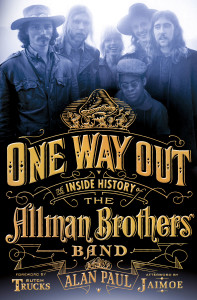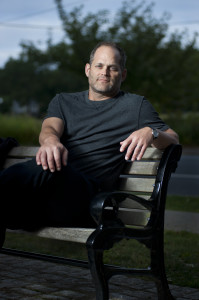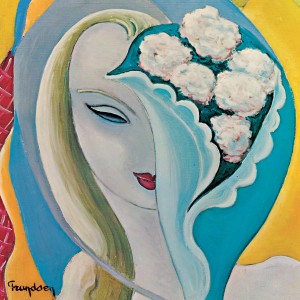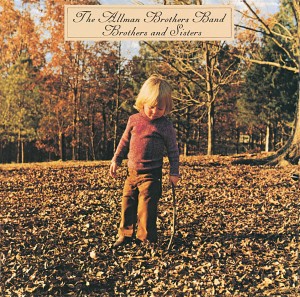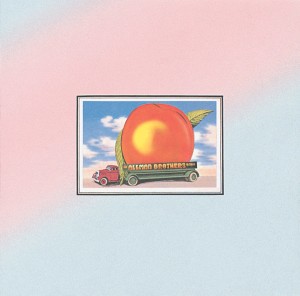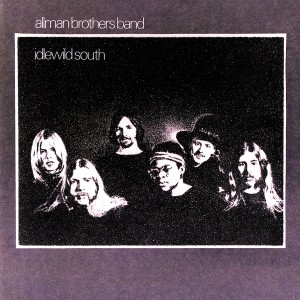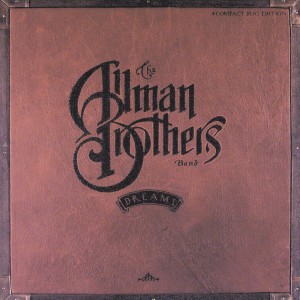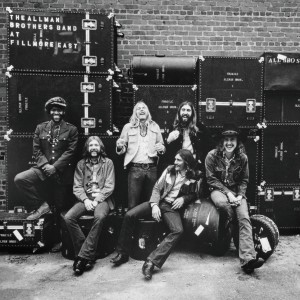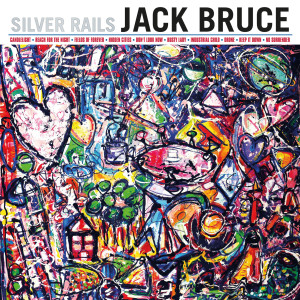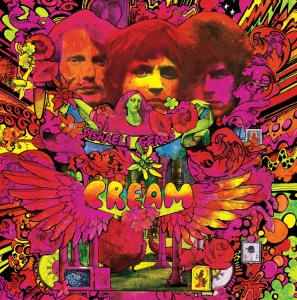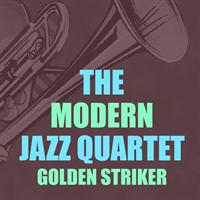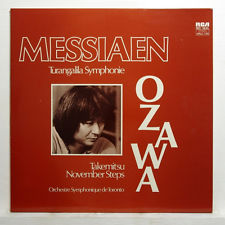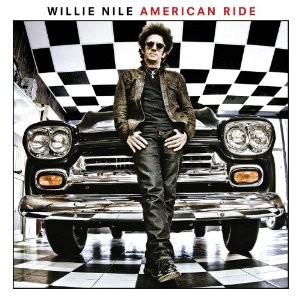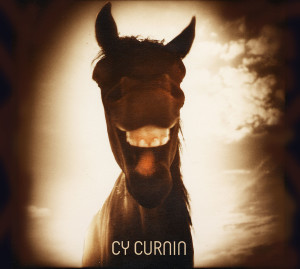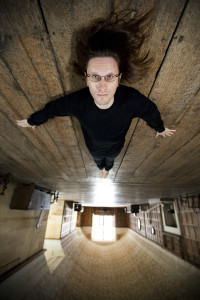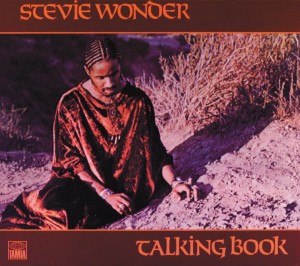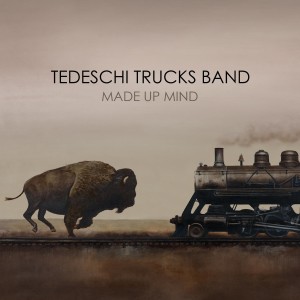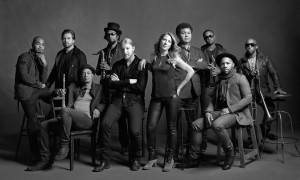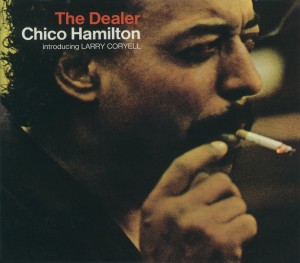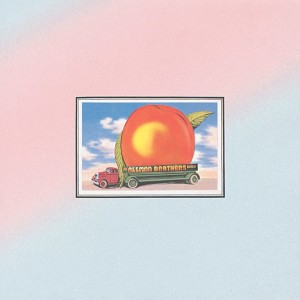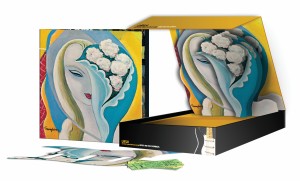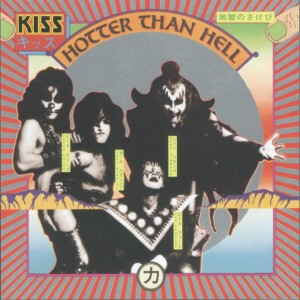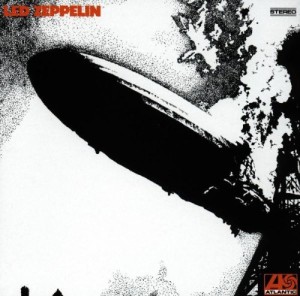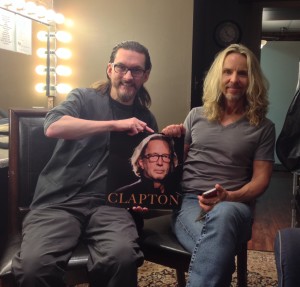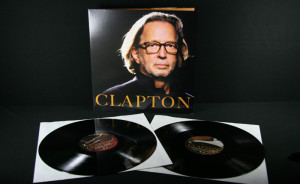If knowledge is power, then Alan Paul is the chairman of The Allman Brothers board. His definitive inside history of The Allman Brothers Band, One Way Out (St. Martin’s Press), is one of the most thorough, in-depth, and best-researched rock biographies I’ve had the pleasure to read — and if you know me, you know I pretty much read ‘em all. Though I’m a diehard Allmans fan and I’ve personally interviewed ABB members Gregg Allman, Butch Trucks, Warren Haynes, and Derek Trucks, I learned something new with just about every turn of the page. Alan’s first-hand reporting and meticulous research, presented in the oral-history format and strategically interspersed with his own insightful commentary, is so spot-on that one could almost retitle the book One Way In.
I first met Alan in early 1991 when I started writing freelance for Guitar World (he remains a ... Read More »]]>
If knowledge is power, then Alan Paul is the chairman of The Allman Brothers board. His definitive inside history of The Allman Brothers Band, One Way Out (St. Martin’s Press), is one of the most thorough, in-depth, and best-researched rock biographies I’ve had the pleasure to read — and if you know me, you know I pretty much read ‘em all. Though I’m a diehard Allmans fan and I’ve personally interviewed ABB members Gregg Allman, Butch Trucks, Warren Haynes, and Derek Trucks, I learned something new with just about every turn of the page. Alan’s first-hand reporting and meticulous research, presented in the oral-history format and strategically interspersed with his own insightful commentary, is so spot-on that one could almost retitle the book One Way In.
I first met Alan in early 1991 when I started writing freelance for Guitar World (he remains a senior editor there today), and whenever he’d sink his teeth into stories about the likes of Albert King, The Doors, Lynyrd Skynyrd, and ZZ Top, I knew I’d be in for a damn good read. Recently, after devouring One Way Out, I asked Alan about the highlights of The Allman Brothers Band’s recorded legacy, Duane Allman’s involvement with Layla, and what he thinks about the ABB’s infamous runs at the Beacon Theatre in New York — and whether the band will go on.
Mike Mettler: What was the most shocking and/or surprising thing you learned while researching One Way Out?
Alan Paul: Not any one thing as much as an accumulation of details helping me — and hopefully my readers — understand the dynamics of the relationships between all members of the band. Duane Allman was the one with the vision for this very different band, and he was the one everyone looked up to and he held the thing together. I knew all that, but not the full extent of his charismatic leadership and the struggles to hold it together for so many decades without him.
I also developed an even deeper understanding of the tensions that led to Dickey Betts’ ouster from the band and the extent to which being in the band with him was living in a constant state of being bullied. It all blew up in 1996 in an Idaho hotel room. I outlined the details, which involve a knife, in the book. I knew the basics, but not the specifics, until my reporting for One Way Out. It’s all complicated, because Dickey pulled the thing out of the fire after Duane’s death and was the undisputed musical leader afterwards, and they never would have had the success they did without him, but it just reached a breaking point.
I also had not really realized that [bassist] Allen Woody was basically fired from the band — and it was all because he stood up to Dickey in that hotel room.
Mettler: If you had the chance to go back in time and meet Duane Allman, what would you have asked him?
Paul: Well, I’d most like to sit in the front row and listen to him play! What I’d really be curious to know is to what extent he envisioned what the band would sound like and how he was so sure in meeting and hearing each member that they were right person for the group. His vision of this thing and his ability to find the right people amazes me.
Mettler: Same Q about Berry Oakley.
Paul: Berry and Duane had an amazing relationship. As harmonica player Thom Doucette told me, Duane would think of something he wanted done, and Berry would make it happen. [Longtime Allmans roadie] Red Dog called him The Deacon. I don’t know what my question for Berry would be. I would just like to hang out with him because he seems like an amazing guy. [Original ABB bassist Oakley died after a motorcycle accident in Macon, Georgia on November 11, 1972, three blocks from Duane's fatal motorcycle accident on October 29, 1971.]
Mettler: On page 84, Eric Clapton says that he and Duane were “instant soul mates.” Would you agree? How important were The Layla Sessions to Duane as a player, and, ultimately, to The Allman Brothers Band?
Paul: I’ll have to take Eric’s word for it! By all accounts, Duane felt the same, so yes, I definitely agree. I’m not sure how important the sessions were to The Allman Brothers Band because they were on such a roll and really peaking already.
I would say that the sessions gave Duane confidence, but he never seemed to lack that. I think the sessions were certainly crucial to his overall reputation and allowed a lot more people to hear him — though a vast majority still have no idea it’s him. Most people think it’s all Eric. The fact remains that Duane wrote and played Clapton’s most famous lick, and I truly believe that Duane was who Clapton wanted to be. There’s no comparison in their playing in my mind; Duane is light years ahead.
Mettler: What’s your favorite song featuring Duane on the Layla album?
Paul: I love all of the interplay on Layla, but if I had to pick, I’d go for “Why Does Love Got to Be So Sad” or “Have You Ever Loved a Woman.”
Mettler: Do you think Dickey’s “Ramblin’ Man” changed the group’s direction and/or its leadership?
Paul: I think it reflected a change in leadership and direction more than it changed it [the band]. However, the success of the single and all that followed — stadium tours, etc. — no doubt solidified Dickey’s role as leader, not least in his own mind.
Mettler: Why is Brothers and Sisters an important album in the Allman Brothers canon?
Paul: Brothers and Sisters is a crucial album in the canon, because it definitively showed there could be life after Duane. Last year’s expanded box set is a delight, not least for a fantastic live show it includes [Live at Winterland, September 26, 1973, on Discs 3 and 4]. The way in which pianist Chuck Leavell and bassist Lamar Williams quickly and seamlessly integrated, subtly changing the band’s direction while retaining their essential nature, in the wake of the losses of Duane and Berry, is quite remarkable.
Mettler: Given the “lean years” of the mid-’70s to the late-‘80s, do you see a throughline from 1973’s Brothers and Sisters to their recording resurgence, 1990’s Seven Turns? The title track to Seven Turns is one of my personal favorite ABB songs, by the way.
Paul: Sure. Dickey Betts’ emerging leadership as a singer and songwriter for one thing, and the ability to integrate new talent and keep growing — on Brothers and Sisters with Lamar and Chuck and on Seven Turns with Warren and Woody. And I agree that “Seven Turns” is a great song.
Mettler: You’re a guitar player — what’s your personal favorite Allman Brothers songs to play?
Paul: I love playing “Blue Sky,” “One Way Out,” and “You Don’t Love Me.” I’m more of a rhythm player and singer and haven’t really tackled the more complex songs like “Jessica” and “Liz Reed.”
Mettler: What’s your favorite Allman Brothers song to just sit back and listen to?
Paul: I love listening to a lot of it, but “Dreams” and “Blue Sky” are probably my favorite kick-back songs. The former encapsulates the Gregg songs, the way they band incorporated modal jazz themes from Miles and Coltrane and Duane’s incredible depth. The latter is my favorite Dickey Betts’ major-key song and one of the finest examples of Dickey and Duane’s complementary playing.
Mettler: In the Acknowledgements section of One Way Out, you mention that your brother David turned you on to Eat a Peach. What year was that, and how old were you?
Paul: That was in 1978, when I was 12 years old. I was already a music freak who carried a little transistor radio with one of those white ear pieces around listening to music all the time. I had heard The Allman Brothers on the radio plenty and certainly knew “Ramblin’ Man” and “Jessica,” which were pretty big radio hits. My first actual memory of The Allman Brothers was going with my brother to see a talent show where this dude in a fake silk shirt with a little moustache got up and sang a karaoke style version of “Ramblin’ Man.” I have no clue how he got that backing track, but I thought it was the coolest thing I had ever seen.
Mettler: What was it about Eat a Peach that hooked you on the band?
Paul: It’s hard for me to retrace my steps to being 12 and know what the attraction was, but the talk of brotherhood meant a lot to me, and the artwork on the inside gatefold fascinated me and pulled me into an alternate universe that helped the music come alive. That’s why I was so thrilled to have the same artist, W. David Powell, provide the killer artwork for One Way Out’s end pages.
Mettler: What was the first record you bought as a kid with your own money? What kind of impact did it have on you?
Paul: Man, I have no idea what was first, but I bought a lot of records at National Record Mart in Pittsburgh. I bought tons of 45s before I ever bought an LP. Some early ones I remember buying were Terry Jacks’ “Seasons in the Sun,” some Partridge Family, and Steve Miller Band’s “The Joker.” One year, my big Chanukah present was a Glen Campbell album I had begged for. I bought everything: Cheech and Chong, Allman Brothers, Lynyrd Skynyrd… all of it had a huge impact on me.
Mettler: In the Appendix, you cite Idlewild South at the top of “The Peaches” list of their best albums. Tell me a bit more why you think it’s the ABB’s greatest recorded work.
Paul: I think that “Don’t Keep Me Wondering” and “Please Call Home,” both on Idlewild, are tremendously underrated Gregg songs. It also includes “Midnight Rider,” “Revival” — which is not my favorite song, but includes heavenly guitar harmonies — and the original version of “In Memory of Elizabeth Reed.”
The other contenders would be Brothers and Sisters and Eat A Peach. The reason I chose Idlewild is B&S does not have Duane, and Eat A Peach is only a partial studio album, filled out with great live tracks. If you put a single album together of Eat a Peach studio cuts, it would include “Blue Sky,” “Melissa,” “Stand Back,” “Les Brers in A Minor,” “Little Martha,” and “Ain’t Wastin’ Time No More,” and it would be a tremendous studio album.
Mettler: When was the first time you wrote about the ABB, and who was the first band member you interviewed? How did that experience go?
Paul: In 1990, I was living in Florida on the verge of giving up on being a writer and going to grad school to become a teacher. I got an assignment to write about them in Pulse. I was excited and went out and bought Dreams, their box set, and spent hours listening to it and Seven Turns. I became completely re-engrossed; the experience of writing that article was so profound to me — not just because I interviewed these guys for the first time and wrote about them, but I spent so much time listening to the music and re-immersing myself in it. I interviewed Gregg, Dickey, Warren, Woody, Phil Walden, and Tom Dowd — I went all out!
Then they came to Tampa. I hadn’t finished the article yet, and the show blew me away. It was incredible that they had reinvigorated themselves with Warren Haynes and Allen Woody. Warren made the biggest impression on me because he was standing up there with Dickey and holding his own, and they had new material, which gave them fresh life. I was still seeing The Grateful Dead, and I just started getting more and more disenchanted with their shows. I thought that these two bands were doing similar things, but The Allman Brothers were doing it a million times better.
Then I finished the article, and I went on a trip to Wyoming with my friend Art. We only had a couple of cassettes with us, and one was a 90-minute compilation I’d made from Dreams. As we drove back toward Chicago, we heard on the radio, “Tonight! The Allman Brothers at Tinley Park!” and we just looked at each other and smiled, and drove to the amphitheater. I somehow got tickets and passes from Epic Records, and it was epic! That’s why those two shows made the list.
Mettler: What did you think about Gregg Allman’s autobiography, My Cross to Bear?
Paul: I know too much about how the sausage was made to asses the meal fully, but it’s a good read that presents Gregg’s version of events.
Mettler: When and where was the first Allman Brothers show you saw? How did it affect you?
Paul: Civic Arena, Pittsburgh, 1980. I was thrilled to be there and did not realize it was a horrible era.
Mettler: How many times have you seen them to date? Do you have a particular favorite Allmans show out of all the ones you’ve seen?
Paul: I have no idea how many shows I’ve seen. I’m not a counter. I’d like to have a nice round number to throw out there, but it’s more than 100. There have been a few favorites: the first two times I saw them with Warren Haynes blew my mind. That was 1990 — first in Tampa, then Chicago. I’ve seen so many great ones at the Beacon. In the early ’90s, Dickey and Warren were just killing it. Seeing bluesman Little Milton with them was a thrill, and their 40th anniversary run was tremendous.
Mettler: You got to see all the shows during The Allman Brothers Band’s most recent run at The Beacon Theatre in New York City, the last time they’ll do that there with both Warren Haynes and Derek Trucks as full-time member of the band. How do those shows compare with the many other Beacon shows you’ve seen? What is it about the Beacon that makes it so special to see the ABB play there?
Paul: They played 10, and I went to all of them. I don’t think it will be the last time they are there, because they had to postpone the last four and have promised to reschedule. I think they were leaning toward another fall run anyhow. We’ll see.
Every Beacon show is different, which is part of what makes them so special. There’s just something that goes on in that room, involving the band and the crowd, and the size and the way the room feels and sounds that is different. I’ve seen so many shows there that it’s hard to assess what makes them different. I thought the first few were very solid but a bit reserved, and that they got looser and looser and were really hitting a groove when the run was cancelled.
Mettler: Who do you think they’ll tap to join the band after Warren and Derek actually leave? Who would you like to see them ask to join?
Paul: I really don’t know, and it’s not clear that they will continue. I would prefer them to stop touring or go a completely different direction — like adding a pianist and a sax player or something. I don’t want to see them diminished or hiring guys to play established licks, which is contrary to the whole tradition.
Mettler: One hundred years from now, how will people view The Allman Brothers Band?
Paul: They will still sound both ancient and modern, as they have since their first album, and they will be regarded as one of the greatest rock and roll bands ever. The music does not ever sound dated or unnatural.
]]>The bottom end has never been quite the same since Jack Bruce picked up his first bass over 6 decades ago. The vaunted Cream bassist wrote the book on the art of the low-end hook, as his syncopated approach to playing bass helped shift pop music’s bottom-end emphasis away from just laying down root notes and fifths, in turn opening the door to a more adventurous yet melodically inclined style that laid the foundation for the rock explosion of the ’60s. Turns in both Manfred Mann and John Mayall’s bands set the table for Bruce to connect with Eric Clapton and Ginger Baker and forge Cream, wherein the super Scotsman set the heavy-blues power-trio standard with epic runs and full-band interplay in songs like “I Feel Free,” “Spoonful,” “Politician,” and “Sunshine of Your Love.”
Once Cream curdled, Bruce delved further into ... Read More »]]>
The bottom end has never been quite the same since Jack Bruce picked up his first bass over 6 decades ago. The vaunted Cream bassist wrote the book on the art of the low-end hook, as his syncopated approach to playing bass helped shift pop music’s bottom-end emphasis away from just laying down root notes and fifths, in turn opening the door to a more adventurous yet melodically inclined style that laid the foundation for the rock explosion of the ’60s. Turns in both Manfred Mann and John Mayall’s bands set the table for Bruce to connect with Eric Clapton and Ginger Baker and forge Cream, wherein the super Scotsman set the heavy-blues power-trio standard with epic runs and full-band interplay in songs like “I Feel Free,” “Spoonful,” “Politician,” and “Sunshine of Your Love.”
Once Cream curdled, Bruce delved further into flexing his compositional and jazz chops, as evidenced by his 1970 free-form fusion precursor Things We Like and 2012’s improv-driven, self-titled group tribute to late jazz drummer Tony Williams, Spectrum Road. Silver Rails, his first solo studio effort in 10 years, brings his career-long broad genre explorations under one roof, and it’s packed with primo Jack: the brooding, confessional “Reach for the Night,” the heartfelt piano ballad “Industrial Child,” and the pummeling, deep fuzz of the aptly named “Drone.” Here, Bruce, 70, and I discuss how Rails got on track, cutting sides at Abbey Road Studios, and the eau de Cream. One thing’s for absolute sure: Bruce remains the cream of the crop.
Mike Mettler: Tell me what it was like working at Abbey Road Studios when you were making Silver Rails.
Jack Bruce: It was amazing. Studio One there is so huge. They have the greatest microphone collection in the world; so astounding. There’s a whole department where they have guys who just look after the old mikes. So who knows — you might be singing into the same mike that John Lennon sang into. [chuckles]
It has quite a vibe when you’re in there. It definitely feels different. I think all the musicians I had with me brought their games up a notch because of respect for what’s gone on there — not just The Beatles and Pink Floyd, but all the way back to [noted English composer] Sir Edward Elgar.
Mettler: You’d recorded there before, right?
Bruce: Yes, the first time was in 1965 [for The Graham Bond Organisation's The Sound of '65], quite a while ago. [laughs] I’ve been in and out of there over the years, but not quite as much recently.
Mettler: Would you consider Abbey Road to be one of your favorite studios to record in?
Bruce: I would say, today, it’s the greatest studio in the world. Partly because of the rooms, which are iconic, partly because of the ambience, and partly because of the way they look after it all. Most studios nowadays have a lot of downtime because a lot of things are often going wrong. You don’t get that at Abbey Road. All of the people who work there are very enthusiastic and very, very good at their jobs.
Mettler: Agreed. I’ve met a few of them myself, like Guy Massey and Paul Hicks —
Bruce: Paul is great. And I was very lucky to be able to use Rob Cass, who’s an in-house producer. In fact, it was his idea that I go to Abbey Road and make the record there.
Mettler: Were there any special production choices you made specifically because you were at Abbey Road?
Bruce: I wouldn’t exactly say that, but one of the great things about Abbey Road is, if you use Studio Two and Studio Three as I did, there’s such a great selection of grand pianos! [laughs] You don’t think of things like that beforehand, but they’re always perfectly tuned and immaculate. They had a wonderful Bernstein, a Steinway, and an amazing Yamaha that I didn’t even manage to get to put on the album.
Mettler: One of the things I like about the sound of Silver Rails is that I get a sense of the musician interplay in the same room. There’s a lot to be said for recording everybody looking at each other instead of just dubbing everything.
Bruce: There is a lot to be said for that, yes. I like a little bit of both. Sometimes I like to start off a song very minimally and record the guitar, the piano, and the drums together, and then overdub. A song like “Industrial Child” is like that. It was done very much live, and I wouldn’t do it any other way if I could. I love playing with incredible musicians like that. I wouldn’t want them to just send me a wav file. There’s none of that going on here.
Mettler: Besides “Industrial Child,” do you have any favorite moments for you behind the piano?
Bruce: I think “Hidden Cities,” because that was such a challenge. It was challenging music. Here’s a very strange story that I’ll tell you. When I was very ill about 10 years ago [Bruce had a liver transplant in 2003], I was in an induced coma for a few weeks, and I started writing all of this music while I was comatose — and I remembered a lot of it. The second, sort of quiet part of that song was one of the things I wrote when I was in that condition. It was like experiencing rising light and sound, and I thought, “How am I going to achieve that? How am I going to realize that in actual, practical, physical music?” I didn’t know if I’d ever be able to replicate that piece of music, but we actually got it fairly quickly, with Cindy [Blackman] Santana on drums and Uli John Roth on guitar. The harmonies were done by a group my daughter put together, called Aruba Red. She put together this amazing group of young women. And it was not the easiest thing to sing. They really went for it, and I’m really proud of them.
Mettler: Wow, that’s amazing you were able to bring that all to life.
Bruce: Quite remarkable, yes.
Mettler: One of my favorite songs has to be “Drone,” which is quite heavy, and basically feels like your Black Sabbath track. Did you play that live in the studio and the overdub it later?
Bruce: I was using my old Gibson EB-1 [violin bass], which has got this incredible sound, almost like a barn door. [both laugh] I used a pedal for the effects, but I don’t even know what it’s called. It was given to me by this guy in Japan — he came up to me at a concert and just handed it to me. It’s an incredible pedal, but it doesn’t even have a name on it or anything.
Mettler: Just call it the JB-1, since it’s now officially your own drone. I also heard some planes ready to crash around me at any moment on there.
Bruce: Yeah, the airplane overdub.
Mettler: In the intro, is that just amp buzz and feedback when you’re starting up?
Bruce: It is, yeah; nothing else. And very good miking. And a little bit of pre-amping is always nice. But you do have to go for separation to a certain extent. It’s a be-all and end-all for me.
 Mettler: Another thing I like is that the tonal character of your voice is still fantastic. What’s the secret? How have you been able to maintain it all these years?
Mettler: Another thing I like is that the tonal character of your voice is still fantastic. What’s the secret? How have you been able to maintain it all these years?
Bruce: [laughs] I don’t know! I don’t have any magic thing I do. Well, I was actually a classically trained singer, and I think that helps, since I know which muscles to use, and not. Every style of singing is valid in my book, but if you want to be singing at a certain level for 40 years or more over your lifetime, well, it’s a good idea to know about how to use those muscles.
Mettler: Since you continue to play live, we the audience still want to hear those qualities in your voice, especially when you sing falsetto and the more delicate parts.
Bruce: There is an almost falsetto, “head” voice that I use, and always have, especially with Cream. On “I Feel Free,” for instance, I used that head voice.
Mettler: And you still play that song live, right?
Bruce: I have done “I Feel Free,” yes. I used to do it when I played with Ringo [Starr, on his recurring All-Starr Band tours]. But normally, I don’t do that [with my solo band] because it needs all of those other vocals, you know. There are a lot of vocals on there, so unless I have a big vocal group, I can’t do it, really.
Mettler: Speaking of Cream, I’ve enjoyed the higher-grade LP reissues of the core catalog. And I have to say “Tales of Brave Ulysses” is one of my favorite Cream tracks to spin on vinyl.
Bruce: I agree, “Ulysses” is great on vinyl. I think “I Feel Free” could still be vastly improved — that one was recorded quite badly. It might be nice to tinker with that someday, but I don’t think the master tapes exist anymore. I think a lot of them were destroyed in a fire in Holland.
Mettler: That’s a shame. Well, I do think “Sunshine of Your Love” sounds as vibrant as ever on LP.
Bruce: I still enjoy all those songs, really. I play very different versions of them now.
Mettler: How do you rearrange a song like “Sunshine“?
Bruce: My touring band at the moment is an 8-piece. I have another bass player so I can play piano some of the time, and I’ve got three great horn players. So it’s great to be able to rearrange “Sunshine” for that group, you know. About a year or so ago [on November 11, 2012], I sat in with Carlos Santana in Las Vegas, and we did his [Guitar Heaven] version of it. [Santana has a recurring residency at the House of Blues at Mandalay Bay in Las Vegas. They played “Spoonful” that night too—The SoundBard]
Mettler: Even today, I think people undervalue the way a song like “White Room” was arranged.
Bruce: And also the way it’s written was quite a little bit different. That’s what I always wanted to do: Write songs that had a little twist in them. And that one wasn’t too off the wall for that band.
Mettler: I got to see one of the Cream reunion shows at Madison Square Garden in New York [on October 26, 2005], and I liked the approach you guys took, which was often different from the original recordings. You must have enjoyed that level of freedom.
Bruce: Yes, thanks. As you mature and get older, you’re going to play things differently. I like to listen to people who are still making vital music — people like Bob Dylan, even if some people don’t seem to like his voice now. I love anything he does. Together Through Life [2009] — that’s a good album.
Mettler: It sure is. As far as I’m concerned, Dylan should keep doing whatever he wants to do as long as he wants to do it.
Bruce: I don’t blame him. You’ve got the right to do that as an artist.
Mettler: And so do you! Ok, let me jog your memory even more. Do you remember the first record you ever bought with your own money?
Bruce: Yeah! The first one was Golden Striker [1957], by The MJQ, The Modern Jazz Quartet. When I was at college, I saw them live, and I went out and bought this EP.
Mettler: That was when you were at the Royal Scottish Academy?
Bruce: Exactly. I tried to bring it in for my professors to listen to, but they didn’t want to know about it. I had gone to see The MJQ in concert, in Glasgow. And I found their bass player, Percy Heath, was very inspirational.
Mettler: So that’s what made you decide to pursue the low end, literally?
Bruce: Yeah, absolutely. I had heard Ray Brown, Percy Heath, and Charles Mingus, of course. And that’s why I fell in love with the double bass.
Mettler: The melodic bass style that people almost take for granted today was really your bailiwick. You set that table.
Bruce: Yeah, that was my deliberate attempt to do that. I wanted to do that because, at that time, I heard James Jamerson [the Motown bassist], and I liked what he was doing, so I wanted to go for that whole melodic style. I used the jazz approach and applied it to bass guitar.
Mettler: While I’ve been enjoying Silver Rails on CD and digitally, I’m very pleased to see that it is coming out on vinyl.
Bruce: It is, yeah, but unfortunately minus “No Surrender” [the last track on the CD version]. We just couldn’t squeeze it on. It would have been a little too much for the sound quality.
Mettler: Is vinyl the format you prefer as a listener?
Bruce: I like vinyl, but then again, I’ve always liked whatever is new. [chuckles] I like the convenience of CDs, I must admit. And obviously, I’ve got a smartphone like everybody else, and hundreds if not thousands of tunes on there as well. It’s quite remarkable what you can have on such a little device.
Mettler: For a record like Silver Rails, considering the amount of detail — the organ interplay with the horns, and a lot of the cymbal work — it seems to me that you’ll get a lot more out of it by listening on vinyl.
Bruce: I totally agree. I love vinyl. I don’t buy new vinyls that much, because I’ve got such a big collection from the ’60s and onwards. I even have some very old pre-vinyl records — you know, the shellac ones, some even from the ’30s and so on. The sound quality of those — I mean, obviously, it’s a bit scratchy, but the way they were able to record in the ’30s is just remarkable, often using only one microphone. I’ve got a [French composer Joseph-Maurice] Ravel piece that’s conducted by him, and some Louis Armstrong Hot Five and Hot Seven sides. The way they did it, just by setting up — the louder you were, the further away you were. I don’t know how they managed that, to get that incredible sound.
Mettler: Any other favorite records you can mention?
Bruce: I like a lot of classical music. There’s a wonderful recording by [Seiji] Ozawa, a Japanese conductor, of the Messiaen Turangalila Symphony [1967] that’s remarkable. There is an argument to be made for both vinyl and digital for classical music. The clarity of digital can be quite useful, but sometimes it can be quite, quite cold.
Mettler: I think having an appreciation for a wide variety of music — classical, jazz, blues, etc. — gives you a broader palette to draw from as a musician. Artists just starting out should take a cue from what you did and go all the way back to the source.
Bruce: They may think going all the way back means going back to Led Zeppelin, or something. Or Cream. [both laugh] Worth checking things out a bit further back than us, I think.
]]>Damn the naysayers — I say the album format lives! With that vital declaration out of the way, it’s high time to cite the records that caught hold of my expert ear over the past 12 months — the full-length discs and/or LPs I consider most worthy of purchase, hi-res download, and/or dropping the needle on! Here, in reverse order, are my favorite 25 albums of 2013. Happy spinning!
25. Jim James: Regions of Light and Sound of God. Mind-/soul-/ear-expanding. Amen, J-man.
24. Kings of Leon: Mechanical Bull. Cojones-shaking rawk.
23. Matthew Sweet and Susanna Hoffs: Under the Covers, Vol. 3. Sid and Susie give the ’80s a deep, loving soul kiss. Read my interview with Sid and Susie here.
22. The Rides: Can’t Get Enough. Super Session, Millennial Style: Stephen Stills, Kenny Wayne Shepherd, and Barry Goldberg burn on down the ... Read More »]]>
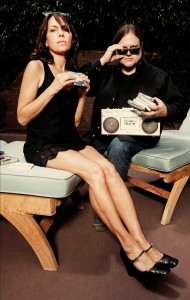
Radio Free, You’re Up: Sid and Susie (a.k.a. Matthew Sweet and Susanna Hoffs) oh-so-magically dial in the ’80s at #23. Photo by Drew Reynolds.
BY MIKE METTLER
Damn the naysayers — I say the album format lives! With that vital declaration out of the way, it’s high time to cite the records that caught hold of my expert ear over the past 12 months — the full-length discs and/or LPs I consider most worthy of purchase, hi-res download, and/or dropping the needle on! Here, in reverse order, are my favorite 25 albums of 2013. Happy spinning!
25. Jim James: Regions of Light and Sound of God. Mind-/soul-/ear-expanding. Amen, J-man.
24. Kings of Leon: Mechanical Bull. Cojones-shaking rawk.
23. Matthew Sweet and Susanna Hoffs: Under the Covers, Vol. 3. Sid and Susie give the ’80s a deep, loving soul kiss. Read my interview with Sid and Susie here.
22. The Rides: Can’t Get Enough. Super Session, Millennial Style: Stephen Stills, Kenny Wayne Shepherd, and Barry Goldberg burn on down the crossroads.
21. Ed Kowalczyk: The Flood and the Mercy. Ex-Live frontman does what he does best — and he does it more earnest, more intense, and more direct than ever.
20. Bob Dylan: Another Self Portrait (1969-1971) — The Bootleg Series Vol. 10. When Bob painted a better masterpiece, on wax canvas.
19. Billy Talbot Band: On the Road to Spearfish. Crazy Horse bassman jams on, casting his lifeline ever deeper.
18. Devon Allman: Turquoise. Son of Gregg churns out heaps of hot blues, rock, and soul chops for days.
17. Richard X. Heyman: X. Underground roots rockin’ cauldron of pure pop perfection. D’oh boy! Read my interview with RXH here.
16. Willie Nile: American Ride. Supersongwriter drives hard ’n true right outta the garage.
15. Eric Clapton: Old Sock. The ax-master at work and at play, and best heard on 180-gram vinyl.
14. Atoms for Peace: Amok. Thom Yorke and friends continue pushing soundscape boundaries.
13. The Flaming Lips: The Terror. Underrated, unwavering exploration of strange and raw emotional chords.
12. Nektar: Time Machine. Unsung ’70s prog veterans keep on ticking forward.
11. Cy Curnin: The Horse’s Mouth. Always prescient Fixx-man spreads his wings and reaps sweet aural karma, Mama.
10. Boston: Life, Love & Hope. Smokin’ guitar and heavenly harmonies as only Tom Scholz can do.
9. Levin Minnemann Rudess: Levin Minnemann Rudess. Push-pull beyond-prog experimentation of the highest order.
8. John Fogerty: Wrote a Song for Everyone. As long as JCF can see the light beyond the Mystic Highway, our ears remain eternally blessed by his songwriting acumen. Best shared moments come with Kid Rock, Bob Seger, and My Morning Jacket.
7. Dream Theater: Dream Theater. Continually adventurous post-prog-metal giants hit new benchmark, best experienced via Richard Chycki’s expansive 5.1 surround-sound mix.
6. Rush: Clockwork Angels Tour. Power-prog trio at their live peak; hearing (and seeing) them do “Manhattan Project,” one of my all-time favorite Rush tracks, with a live string section is a continual treasure. “Imagine a time when it all began…”
5. Sound City: Real to Reel Soundtrack. Dave Grohl’s auditory love letter to an amazing recording studio, with ace collaborations galore.
4. The Band: Live at the Academy of Music 1971. Standard-setting live act carries the weight of an epic residency. If you want to be a beyond-great live band, listen and learn.
3. Steve Hackett: Genesis Revisited – Live at Hammersmith. Ace prog guitarist dances on the volcano of his stellar ’70s legacy and proffers many musical boxfuls of rewarding, top-drawer rearrangements.
2. Tedeschi Trucks Band: Made Up Mind. A supreme blend of improv interplay prowess and gutbucket roots rock, best interwoven on vinyl.
1. Steven Wilson: The Raven That Refused to Sing (and Other Stories). Wholly original, envelope-pushing, mind-blowing, mind-expanding music realized to perfection in the 96/24 LPCM Blu-ray 5.1 mix. The breadth and scope of Raven represent Steven Wilson at the height of his creative powers, where surround-sound music and mixing has reached a heretofore unheard aural apex. My full album evaluation is posted here in High Resolution Reviews.
]]>“That’s the cartridge you want — the one that’ll get you kicked out of the house!” And that’s Derek Trucks, empathizing over the price of high-end audiophile gear, both in terms of how it affects your wallet and your personal life. “I’ve had that conversation too,” he adds with a chuckle. The good-natured Trucks drenched his sweet-toned slide-guitar stamp all over one of 2013’s best albums, the Tedeschi Trucks Band’s Made Up Mind (Masterworks; you can read my 4 1/2-star review of it in the Discs & Downloads section on the Sound & Vision website.) Here, Trucks, 34, and I commune over his favorite gear and LPs, the albums that made the deepest impressions on him growing up, how good Mind sounds on vinyl, and its thematic album parallel. (Hint: “Darling, won’t you ease my worried mind” is ... Read More »]]>
Peakin’ at the Beacon: Mettler and Trucks after waxing on about wax, backstage after a supertasty TTB show, 09.21.13.
BY MIKE METTLER
“That’s the cartridge you want — the one that’ll get you kicked out of the house!” And that’s Derek Trucks, empathizing over the price of high-end audiophile gear, both in terms of how it affects your wallet and your personal life. “I’ve had that conversation too,” he adds with a chuckle. The good-natured Trucks drenched his sweet-toned slide-guitar stamp all over one of 2013’s best albums, the Tedeschi Trucks Band’s Made Up Mind (Masterworks; you can read my 4 1/2-star review of it in the Discs & Downloads section on the Sound & Vision website.) Here, Trucks, 34, and I commune over his favorite gear and LPs, the albums that made the deepest impressions on him growing up, how good Mind sounds on vinyl, and its thematic album parallel. (Hint: “Darling, won’t you ease my worried mind” is a line from the title track.)
Mike Mettler: Is vinyl the format you like best for listening to music?
Derek Trucks: Absolutely. We even bring a turntable on the road with us. We’ll listen to vinyl on the bus, and then when we’re home, that’s pretty much all we listen to.
Mettler: What kind of ’table do you have on the bus?
Trucks: It switches from time to time. We usually bring little portable models with us, because gear gets beat up on the road. The London Souls were out on tour with us recently, and we lent it to them. They had it on their laps in the van, spinning records! They were trumping us, so we donated it to them. I mean, if you put that much time and energy into listening to vinyl on your lap in the van when you’re touring across the country — that’s pretty hardcore. [both laugh]
Mettler: What albums do you bring with you on the road? Or do you just buy records at each stop on the tour?
Trucks: I’ll usually bring about 10 from home, a mixed bag. And then we start at the first record store we see on the road. Everybody contributes. Two to five of us go out, and each of us will buy two to five records. It kind of builds as the tour rolls on.
Mettler: Any records you have at home that you’d consider demo quality, something you’d put on to let people know, “Yeah, this is why vinyl is great”?
Trucks: There are a few. The track “You’ve Got It Bad Girl,” from Stevie Wonder’s Talking Book [1972] — that’s in heavy rotation. Actually, there are a lot of Stevie Wonder tracks that work. You know, I also love the Sly Stone Fresh [1973] album; there’s just something about the way that thing sounds. It kind of depends on the mood. There’s a lot of go-tos.
But Stevie — he was such a master. He did five or six records in a row that were as good as anybody. Ever. Just staggering. And Where I’m Coming From [1971] — that first record where he goes out on his own and does everything himself — there’s some great shit on there.
Mettler: I also love Innervisions [1973]. Put the needle down on something like “Living in the City” — it doesn’t get much better than that.
Trucks: Yeah, that’s a good day. [chuckles]
Mettler: A really good day, Ok, now walk me through the process of getting Made Up Mind onto vinyl.
Trucks: Susan [Tedeschi], Bobby Tis [engineer], Jim Scott [producer/engineer], and I were pretty anal about how it got done. We took about four or five shots at it. It was a process, but we finally got it right.
We’ve mixed our last few records down to tape on the vintage 1976 Neve console in our studio [Swamp Raga Studios in Jacksonville, Florida], and the whole idea is that you should be able to turn it up pretty loud and it should still be warm. The way we approached this mix is we didn’t overcompress it, we didn’t make it overly loud when we were mastering it, and we wanted you to be able to crank it up when you’re playing it. When you do that on a good system, all the vinyl goodness is right there for you. [laughs]
Mettler: An intense track like “The Storm” [Side 4, Track 1], which is one of your guitar showcases, must have required some extra mixing TLC.
Trucks: Totally, especially with a band this big [10 musicians]. There are a lot of frequencies covered in a song like that one. It has to be right. In the end, I feel good about where the sound of this record ended up.
Mettler: Is there one Made Up Mind track that’s your favorite one to drop the needle on?
Trucks: You know, it changes from time to time, but the last time I listened, “It’s So Heavy” [Side 3, Track 1] hit me right. That’s a great track. The feel and the sound of it, and the way Susan’s voice was captured — it just feels so warm and comfortable.
Mettler: Warm and Comfortable — maybe that should be the title for TTB’s next album.
Trucks: [laughs] That’s right. That’s good.
Mettler: You can have it, no charge. What other albums are you currently spinning?
Trucks: Let’s see. There’s this Chico Hamilton record called The Dealer [1966, on Impulse!]. That was one Chris Robinson dropped on us last time we were touring with The Black Crowes, so it’s been in heavy rotation. Then there are a few Taj Mahal records: Giant Step [1969] and Taj Mahal [1968]. And I love that Johnny Jenkins record, Ton-Ton Macoute! [1970], which was a Capricorn record. It’s basically the early Allman Brothers backing up Jenkins. He was a Georgia old-school staple, and he even had Otis Redding in his band [the Pinetoppers] at one point. That’s a bad-ass record. Pretty funky stuff.
Mettler: What kind of gear do you have in your home setup?
Trucks: We have a VPI Scout ’table in the house, and a model up from that one out in the studio. We have B&W Signature 800 Series speakers, and they look like R2-D2; those things are monsters! [laughs] We have a Manley Snapper for the bottom end, a Manley Stingray iTube for the mids, and we’re using a Manley Steelhead for the preamp. It’s a pretty crushing setup.
I remember a few years ago when I finally got the system up and running, I’d bring people up to the stereo upstairs and would play them a few records, and [The Allman Brothers Band’s] Eat a Peach was one of them. First I’d play it on CD because it sounds really good on my system, but then halfway through I’d switch over to the vinyl, and then the whole world would open up. It just starts feeling like music again. I have an original pressing of Peach, and the guitar sounds on “Blue Sky” — those are my favorite Duane [Allman] moments on record. It’s just relaxed and in the cut, and that’s the way it should be.
Mettler: Did you ever think growing up that you’d wind up playing a lot of those tunes yourself with the people who made them? Was it in the back of your mind?
Trucks: I never thought I’d get a chance to play that music with them, no. That stuff seemed like it was from a time passed. The records that I grew up listening to in heavy rotation were [The Allman Brothers Band’s] At Fillmore East, Eat a Peach, the Layla record, and Elmore James [Blues After Hours]. Those were the four LPs that were spinning from before I can even remember, and from when I first started playing around and out. To get to play the majority of that music with those artists — it’s definitely been surreal.
But listening to that music now — something I’ve noticed with playing them on CD is it feels like an approximation. It’s cold. And then you put on vinyl, and you’re in it. There’s something more human and musical about it. I also find that I end up listening longer to vinyl. I don’t get fatigued.
Mettler: I can totally relate to that. Let’s talk about the last track on Made Up Mind, “Calling Out to You” [Side 4, Track 2]. In my album review, I called it the “acoustic digestif,” the perfect ending to the record. Listening to it closely, I heard some foot-tapping going on all throughout. That was you, right?
Trucks: Yeah. When we cut that tune, we had just finished writing it, and it was really the first time we played it all the way through. Susan was about 4 feet away from me on her vocal mike, and the guitar was bleeding into the vocal mikes and the guitar mikes, and my foot was just tapping on the floor. When we were listening back to that demo, there was something about the way it felt and the honesty of it that I kept thinking, “That’s it. There’s no reason to add anything there.”
Mettler: I like hearing those kinds of bleeds. That sounds more organic and more honest to me. Sometimes you can take the emotion right out of a mix if you’re trying to be too perfect.
Trucks: Oh yes, absolutely. That’s one of the hardest things: When you get into the studio and you have the ability to take as much time as you want, knowing when to stop is tough. Step away from the board! [both laugh]
Mettler: There’s a parallel between “Calling Out to You” and the last song on an album you know inside and out: “Thorn Tree in the Garden,” from Derek and the Dominos’ Layla and Other Assorted Love Songs. Both Made Up Mind and Layla end in a similar way, emotionally speaking.
Trucks: “Thorn Tree” is a great track, and it’s such a great way to end that record, yeah. You know, I wasn’t thinking about it directly at the time, but now that you mention it, I can see it.
I think the first time I remember hearing our record end with that song, I thought it sounded like a quiet prayer. And for almost every record I’ve made, that’s the sentiment I want to go out with. Without even knowing the way that record was sequenced originally, it’s a song that sticks with you. It evokes such a feeling that it becomes the bottom line. I love records that go out that way — they aren’t yelling at you, but they’re kind of letting you down softly. [chuckles] You know, talking about the record like this makes me want to go hear the whole thing again!
]]>BY MIKE METTLER
“Nothing moves me like the sound of a guitar.” It’s the opening sentence to author Lisa S. Johnson’s passionate introduction to 108 Rock Star Guitars (Glitterati Incorporated), her lavishly photographed and beautifully bound ode to a score of axes ‘n planks that have created some of the most indelible sounds in our lifetime, and I swear I could have written that line myself. I was enamored with guitars even before I learned how to form the chords that open Yes’ “Roundabout” on a no-name acoustic in a junior high school guitar class, and to this day my attention is rapt whenever I hear certain riffs or see guitar wizards both budding and seasoned practicing their own special brands of fretboard magic live.
108 Rock Star Guitars captures many of those jamtastic fretboard-induced feelings between its covers, so if you’re ... Read More »]]>
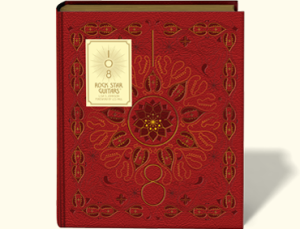
BY MIKE METTLER
“Nothing moves me like the sound of a guitar.” It’s the opening sentence to author Lisa S. Johnson’s passionate introduction to 108 Rock Star Guitars (Glitterati Incorporated), her lavishly photographed and beautifully bound ode to a score of axes ‘n planks that have created some of the most indelible sounds in our lifetime, and I swear I could have written that line myself. I was enamored with guitars even before I learned how to form the chords that open Yes’ “Roundabout” on a no-name acoustic in a junior high school guitar class, and to this day my attention is rapt whenever I hear certain riffs or see guitar wizards both budding and seasoned practicing their own special brands of fretboard magic live.
108 Rock Star Guitars captures many of those jamtastic fretboard-induced feelings between its covers, so if you’re looking for an extra-special tome for the music lover on your holiday shopping list, then you’ve come to the right place.
“Living guitar art” is a phrase used to describe the photos Johnson took over the course of the 15 years needed to compile this book, and it’s quite apt. The angles are dramatic and the luthiers’ detail work well evident in each guitar shown within. It’s not easy to choose favorites — especially since I continue to comb through the book like it’s a lost rune, and I could probably cite them all — but, ok, fine, I will list some of them here nonetheless: Jack White’s crackled early-’60s Airline. Eric Clapton’s 1956 Fender Stratocaster, a.k.a. “Brownie.” (Yes, that’s the one he used to record “Layla.”) Geddy Lee’s 1972 Fender Jazz bass. (Natural wood, people!) Rick Nielsen’s checkerboard Hamer “Enola.” Phil Collen’s 1985 Jackson Custom Shop “Crackle.” Brian Setzer’s 1959 Gretsch 6120 “Stray Cat.” Jimmy Page’s 1968 Gibson EDS 1275 SG double neck. Bonnie Raitt’s “Brownie” Stratocaster. Lou Reed’s Bolin NS with customized silver skull control knob. Tommy Shaw’s Fender Electric XII and 1998 Gibson Les Paul. James “JY” Young’s 2001 Fender Stratocaster and JY Custom “Cerberuscaster” — and yes, the look of the mythical three-headed creature on the latter axe is as cool as you think. And as I recently discovered, I happened to be in the house and backstage when the two Styx men’s guitars were being photographed on August 2, 2011 at the Greek Theatre in Los Angeles. “Tommy and JY play off of each other so well — they’re two pros who are a joy to watch,” Johnson told me recently about her experience at that show, and I have to agree.
Naturally, I also asked Johnson a few SoundBard-ian Qs, and herewith is our exchange on those weighty topics.
Mike Mettler: What was the first album you bought with your own money, and what do you remember about how it sounded to you?
Lisa S. Johnson: My first album was Kiss: Hotter Than Hell [1980]. I loved their costumes and the album cover art. I played it over and over on my very cheap turntable. I clearly remember the sound of the needle dropping on that record. I was 11 years old and so impressed with the hard-rock sound and sexy lyrics, but my ear was not trained yet to hear for anything specific; I just knew that I loved it. Until then, I had pretty much grown up on a lot of country classics, so it was quite a revelation.
Mettler: Do you still own that record?
Johnson: I still own the LP, yes. It’s stored up in Canada at my mother’s house.
Mettler: What’s your favorite guitar-oriented album, and why?
Johnson: Led Zeppelin [1969] is a real favorite. Jimmy Page is such an innovative guitar player. Everything he did was new to my ears, so I love the originality of this material — and I especially love “Dazed and Confused.” Jimmy playing his guitar with a bow is incredibly moving, and it takes me out of my body.
Mettler: Is vinyl still the best way to listen to music?
Johnson: I don’t own a turntable anymore, but I’m seriously thinking I’d better get one again. [Please do!—Your LP Lovin' SoundBard] Vinyl is back in a serious way, despite that digital is here to stay. Vinyl just offers a deeper, more luscious listening experience that adds an organic feeling to the sounds you are hearing.
]]>BY MIKE METTLER
Get Tommy Shaw and me, Mr. SoundBard, in a room talking about music, and chances are you’ll have to drag us out by our respective ears to get us on the way to our next destinations. (Just ask Styx’s ever-patient, ever-gracious tour manager and assistant tour manager.) Tommy and I bonded over a mutual passion for music, and especially vinyl, years ago, and we share our LP love regularly in text, photo, and email. A typical message might begin along the lines of “Look what I found!” and subsequently “You won’t believe how GOOD this album sounds!” — followed soon thereafter by a fervent discourse on all of the aural subtleties and production nuances that cause us to pick the needle up and play that record again and again and again.
That’s my ’round-the-bend way of saying welcome to ... Read More »]]>
BY MIKE METTLER
Get Tommy Shaw and me, Mr. SoundBard, in a room talking about music, and chances are you’ll have to drag us out by our respective ears to get us on the way to our next destinations. (Just ask Styx’s ever-patient, ever-gracious tour manager and assistant tour manager.) Tommy and I bonded over a mutual passion for music, and especially vinyl, years ago, and we share our LP love regularly in text, photo, and email. A typical message might begin along the lines of “Look what I found!” and subsequently “You won’t believe how GOOD this album sounds!” — followed soon thereafter by a fervent discourse on all of the aural subtleties and production nuances that cause us to pick the needle up and play that record again and again and again.
That’s my ’round-the-bend way of saying welcome to the debut installment of The Vinyl Brothers videoclip Q&A series, wherein Mr. Shaw and I will discuss the sonic merits of a cherished album, whether it be a longtime favorite, a remastered classic, or a new discovery. Our initial subject is Eric Clapton‘s underrated 2010 release, Clapton. Sitting in his dressing room backstage after Styx had performed a particularly rousing set at Bergen PAC in Englewood, NJ on October 19, 2013, Tommy asked me if I had heard this album, as he had been particularly taken with the tone and tempo of Track 1 on Side 1, “Travelin’ Alone” — so much so that he often found himself picking up a guitar and playing right along with it. While I had indeed bought the record when it came out almost 3 years ago, I admitted that I had hardly spent any time with it, so I clearly needed a 33 1/3 refresher spin or two. I duly pulled it off the shelves (it was slotted in between EC’s current Old Sock LP and the three-LP box set for EC & Steve Winwood’s Live From Madison Square Garden) and brought it to Styx’s gig the following night, October 20, at State Theatre in New Brunswick, NJ, so we could talk about it after the show. We tell the double 180-gram Clapton LP’s tantalizing tale in the YouTube clip at the top of this post.
And, as always, enjoy the music.
]]>